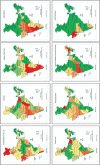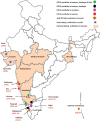Emerging/re-emerging viral diseases & new viruses on the Indian horizon
- PMID: 31411169
- PMCID: PMC6676836
- DOI: 10.4103/ijmr.IJMR_1239_18
Emerging/re-emerging viral diseases & new viruses on the Indian horizon
Erratum in
-
Erratum: Emerging/re-emerging viral diseases & new viruses on the Indian horizon.Indian J Med Res. 2019 May;149(5):688. doi: 10.4103/0971-5916.264276. Indian J Med Res. 2019. PMID: 31417043 Free PMC article.
Abstract
Infectious diseases remain as the major causes of human and animal morbidity and mortality leading to significant healthcare expenditure in India. The country has experienced the outbreaks and epidemics of many infectious diseases. However, enormous successes have been obtained against the control of major epidemic diseases, such as malaria, plague, leprosy and cholera, in the past. The country's vast terrains of extreme geo-climatic differences and uneven population distribution present unique patterns of distribution of viral diseases. Dynamic interplays of biological, socio-cultural and ecological factors, together with novel aspects of human-animal interphase, pose additional challenges with respect to the emergence of infectious diseases. The important challenges faced in the control and prevention of emerging and re-emerging infectious diseases range from understanding the impact of factors that are necessary for the emergence, to development of strengthened surveillance systems that can mitigate human suffering and death. In this article, the major emerging and re-emerging viral infections of public health importance have been reviewed that have already been included in the Integrated Disease Surveillance Programme.
Keywords: Avian influenza; CCHF; India; Nipah virus; emerging; re-emerging; respiratory viral infections; rotavirus; viral diseases.
Conflict of interest statement
None
Figures





References
-
- World Health Organization, South-East Asia Region, Western Pacific Region. Asia Pacific strategy for emerging diseases: 2010. New Delhi, Manila: WHO, South-East Asia Region, Western Pacific Region; 2011.
-
- Tran TH, Nguyen TL, Nguyen TD, Luong TS, Pham PM, Nguyen V, et al. Avian Influenza A (H5N1) in 10 patients in Vietnam. N Engl J Med. 2004;350:1179–88. - PubMed
Publication types
MeSH terms
LinkOut - more resources
Full Text Sources
Medical
Miscellaneous
